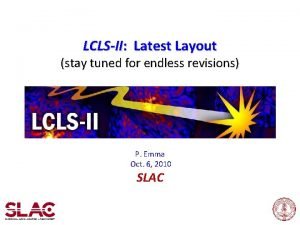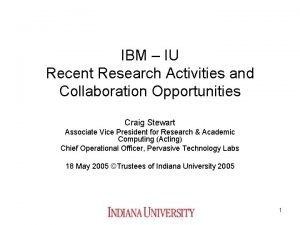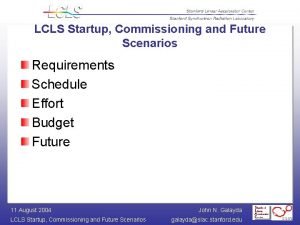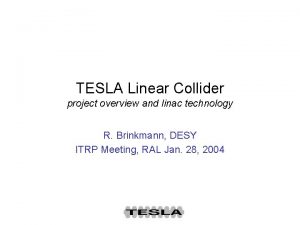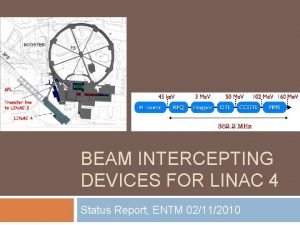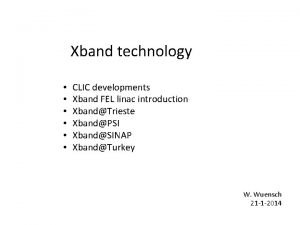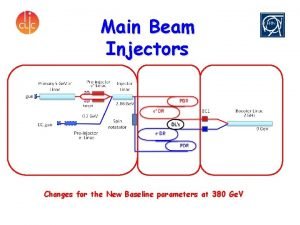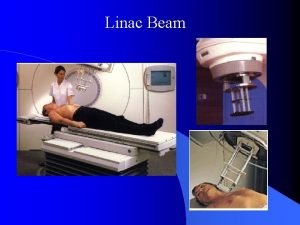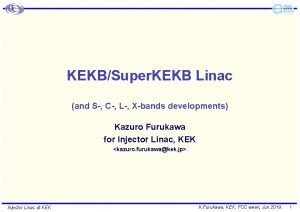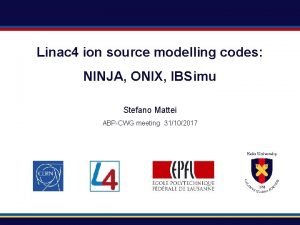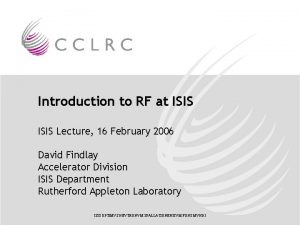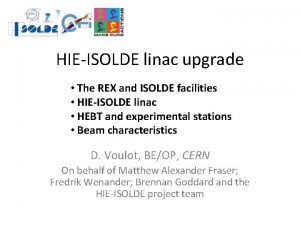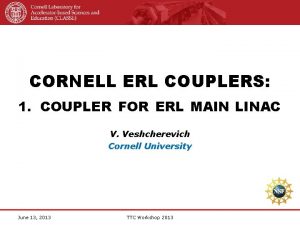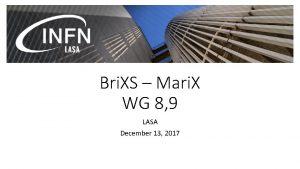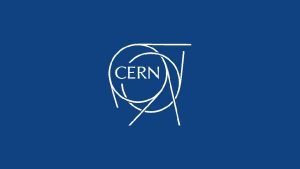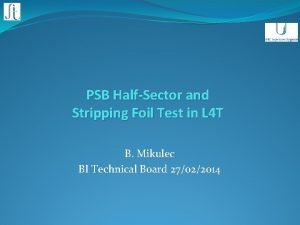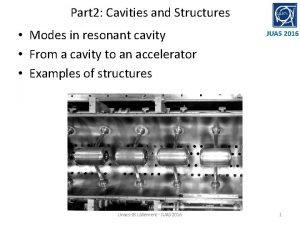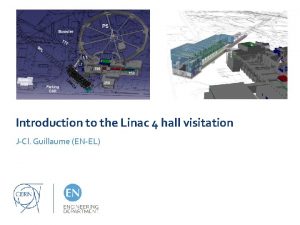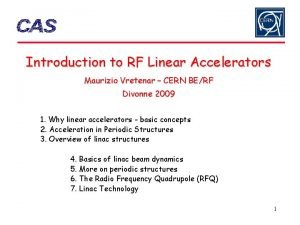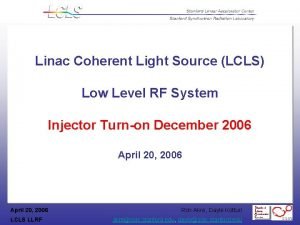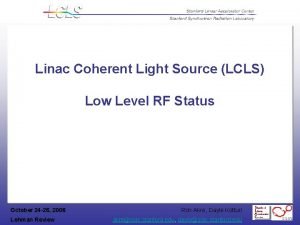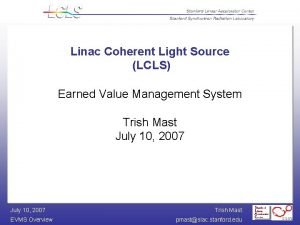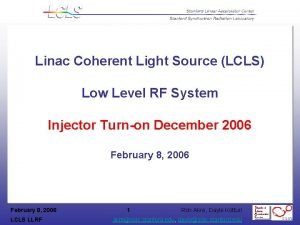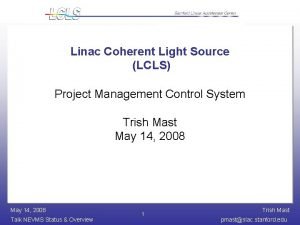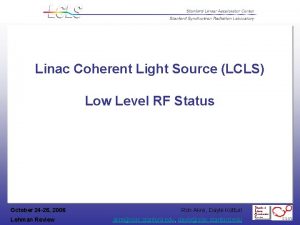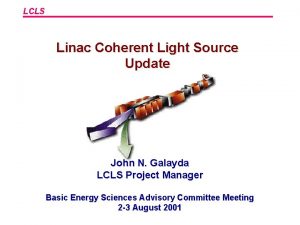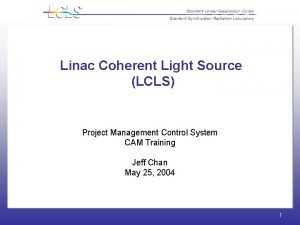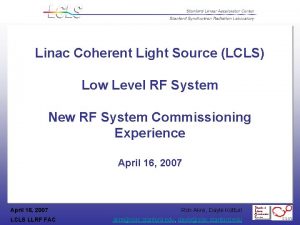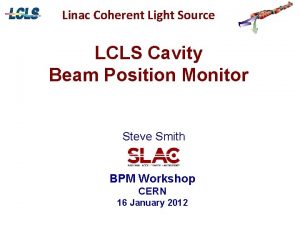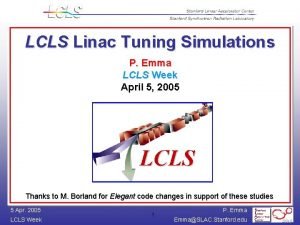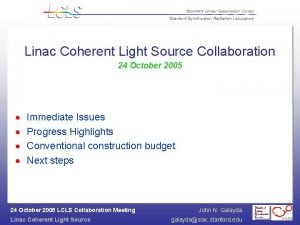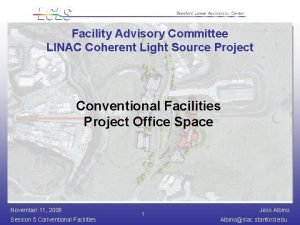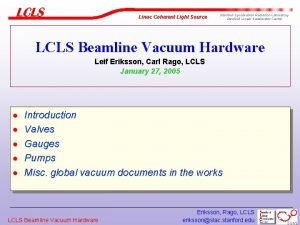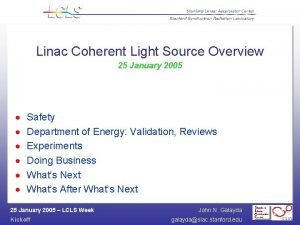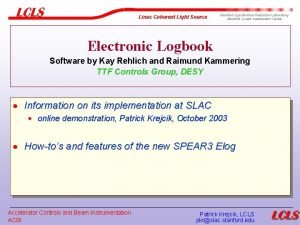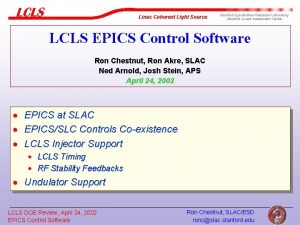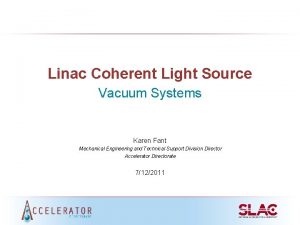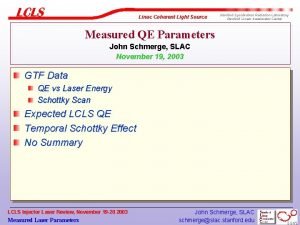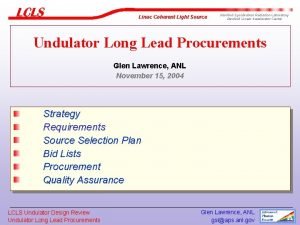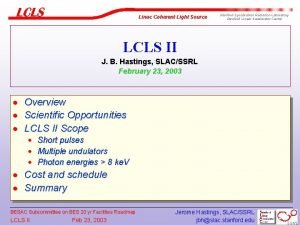The Linac Coherent Light Source LCLS Free Electron






















- Slides: 22

The Linac Coherent Light Source (LCLS) Free Electron Laser (FEL) Performance Program With focus on Reproducibility. William S. Colocho, WAO, October 2014

Outline • • • LCLS FEL at a glance. Time Accounting FEL Performance program Reproducibility issues Future Work Questions 2

Linac Coherent Light Source – Free Electron Laser The LCLS is the world’s most powerful X-ray laser. Its highly focused beam, which arrives in bursts a few to ~120 femtoseconds long, allows researchers to probe complex, ultra-small structures and freeze atomic motions, thus shedding light on fundamental processes of chemistry, materials and energy science, technology and life itself. 3

The LCLS Operation Strategy • Capacity Increase the experimental capacity of LCLS by performing simultaneous experiments via beam splitting and sharing methods • Capability Develop new capabilities such as pulse control and characterization, detection and control systems, sample environment and delivery • Efficiency Transition LCLS operations from the “start-up” phase to a more efficient sustainable mode that is scalable to LCLS-II Uwe Bergmann 4

Capacity is the Major Limitation for LCLS October 2009 250 200 August 2014 45% % Proposals 40% Scheduled 35% 30% 150 # of Proposals Received 25% 20% 100 15% 10% 50 5% 0 Run 1 Run 2 Run 3 Run 4 Run 5 Run 6 Run 7 Run 8 Run 9 2088 2256 2184 2256 2772 2388 3120 2700 2280 hrs hrs hrs 0% Uwe Bergmann 5

Increase LCLS Capacity by Beam Sharing Mirror for MEC 100 µm thick diamond crystal • Successful demonstration of two simultaneous experiments XPP/CXI during in-house research • 3 user experiment performed in Run 8, first one at XPP/MEC • 7 user experiments performed in Run 9 resulting in 20% more user time • Second set of diamond crystals for the XCS mono underway • Work underway at CXI to use the beam for two back-to-back experiments • In the process to attract funding for a new Hutch 6

Time accounting • LCLS User runs are planned for 10/12 months each calendar year. • Each week of a run includes on average 5 days for User experiments and 2 days for Non-User time. Scheduled Off Photon MD Machine Dev. Users Reliability Machine Dev. Users 4% 23% 55% Availability • Time spent tuning is counted an unavailable to Users. • MD Reliability is lower by 4. 4%! We shift maintenance tasking risk to Machine Development periods. 93, 8% Photon MD 19% 90, 5% 92, 0% 88, 4% 96, 4% 95, 0% 7

Non-User Time Scheduling • Setup: Setup FEL for User specified parameters (Wavelength, pulse intensity, bunch length, etc. ) • Maintenance: tune-up of energized equipment, injector laser tuning and software releases. • Performance Programs: • Capability: Develop new FEL capabilities that align with changing user interests and future needs. • Stability: Improve jitter. • Reproducibility: Reduce setup and tuning time • Quality: Achieve higher FEL beam parameter values • Photon: Develop or commission common x-ray beam lines. https: //portal. slac. stanford. edu/sites/lclscore_public/Pages/FEL-Performance-Programs. aspx 8

Reproducibility • Pulse intensity reproducibility target is to achieve 75% of previously attained performance by restoring control devise configuration. • Pulse intensity is dependent on many other configuration factors including photon wavelength (e- energy) and photon bunch length (e- peak current). 9

Reproducibility topics Injector Laser profile on VCC Laser heater 3 D overlap Gun Amplitude L 1 X orbit offset L 2/L 3 RF gain stability BC 2 dispersion LTU emittance growth Lateral drift motion of LTU QUAD(s). Undulator launch orbit Undulator K degradation. SASE gain disturbances across undulator chicanes. UND chicane phase. Injector QUADs BBA. Operations – Physicist communication. Large parameter optimization space. Large number of configurations Opportunistic measurements. 4: 15 meeting requests seems late. Multiple optimization algorithms. Lattice and orbit control. Orbit control and feedback Magnetic filed reproducibility. (LTU PS) Coupling 10

Reproducibility examples – Injector Laser Profile • Operators on shift identified FEL pulse intensity to be extremely sensitive to injector laser profile • Save profile and try to visually reproduce. • Ways to quantify, track, correlate and monitor profile needed. • Zernike polynomials may help. • Use symmetric/anti-symmetric coefficient (2 values). • R&D to use adaptive optics. Individual coefficients change with time 11

Machine Characterization. • Each operating point includes parameters selected by Users: 280 e. V to 11. 2 Ke. V, 20 p. C to 180 p. C, 10 fs to ~120 fs). • This leads to a large number of different configurations with different intrinsic performance. • Machine characterization takes time. Must work hard at automating and speeding up measurements – Fast wire scanners. • Expert only measurements adapted for operator use. • Develop non invasive ways to monitor parameters. 12

Machine Characterization • Opportunistic during hutch access • Users and hutch scientists may be suspicious of “Non. Invasive” measurements • Hutch access time may not be known or predictable • Operators may prefer to tune or keep beam stable rather than to embark in measurement program • Measurement procedure(s) not well documented. • No value added to current shift. 13

Multiple Optimization Algorithms • Large number of knobs leads to individual optimization approaches. • Physics based “By the book” tune up algorithm has proven to work BUT not all the time. • Minimizing beam emittance is a necessary but not sufficient condition for good performance. Pulse I vs emit • Multiple iterations needed 14

Operations – Physicist communication. • Operations find improved performance from changing parameters that Physicist would expect to set once. (XCAV transverse offset, Hard X-Ray Self Seeding chicane delay) • Easy to get lost in parameter space. • Parameter drift may be caused by hardware issue (Gun Solenoid tweaks due to Gun Amplitude probe issues). • Two logbook systems, multiple programs lead to information overflow • Other activities in the control room require operator attention. (Multi-program operation: FACET, ESTB, SSRL) 15

Other tuning aids, ideas and issues • “Tunagedon” Operator written GUI to automate common tuning tasks • Jitter interferes with tuning efficiency. • Drift interferes with tuning efficiency. • Robust Conjugate Direction Search (RCDS)* has been explored. 16

RCDS * X. Huang, et al, NIMA 726 (2013) 77 -83 Each evaluation took 10. 5 seconds on average (mostly waiting for undulator). X. Huang, 05/01/2014 17

Summary • Accurate time accounting identifies areas of improvement. • New FEL performance program guides schedule. • Reproducibility is tracked at multiple levels and is a key performance indicator for an FEL X-Ray source • A strong parameter characterization program is needed • Good coumnication between Operators and Physicists is a requirement for Reproducibility issues. • Improving machine Reproducibility will decrease setup time and increase machine’s Capacity and Efficiency. 18

Questions 19

Back up slides: Optimization knobs • • • • Injector laser profile Injector phase scans Injector orbit steering Laser Heater timing, transverse profile, intensity (m. J). Orbit at X-Cavity linearizer. Undulator Taper SXRSS and HXRSS phase delay. Undulator orbit launch Linac betatron matching quads LTU betatron matching quads Linac energy gain configuration Linac steering LTU steering • Gun solenoid • BC 1/BC 2/BL 2 dispersion correction • Collimator positions • Bunch compression BC 1/BC 2 • L 3 Vernier • L 3 chirp • electron charge • Undulator pointing 20

Room Temperature Structure of GPCRs - Human serotonin receptor refined to 2. 8 Å LCLS (red) vs Synchrotron (blue) - Average crystal size - LCLS 5 x 5 x 5 mm 3 - Synchrotron 80 x 20 x 10 mm 3 - Only 0. 3 mg of protein used at LCLS - RT structure displays a unique distribution of thermal motions and conformations of residues More accurate receptor structure and dynamics in a cellular environment - Lipidic Cubic Phase Jet Weierstall et al. (2014) Liu et al. Science (2013) Team led by Cherezov 21

FEL Performance Program Examples Capability: Soft X-Ray Self Seeding. Stability: Jitter diagnostics Quality: Seeding Lines, Optics Studies Photon: LODCM for beam sharing 22
